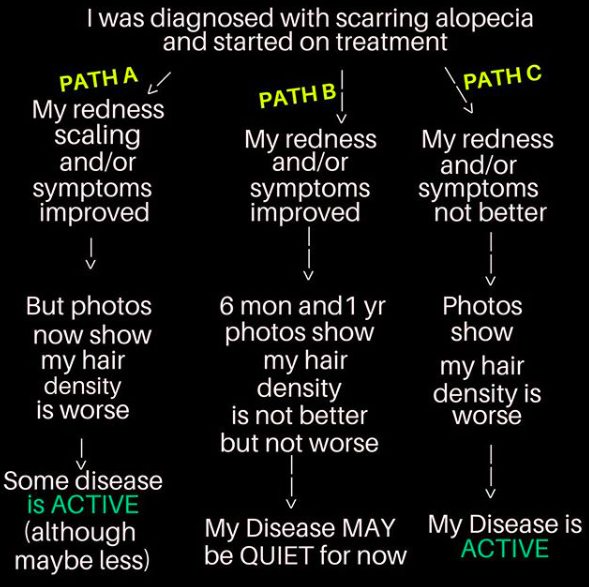Is My Scarring Alopecia "Active"?
Active vs Inactive Scarring Alopecia: Which do I have?
There is often a lot of confusion about whether or not a person’s scarring alopecia is active or not. A good rule is this: If a photograph of the scalp taken 2 years apart shown absolutely no change in density - the scarring alopecia is probably quiet. Now that could be quiet because the medications made it quiet or quiet because it truly is in remission or “burnt out.” If a photo taken 6 months from the last shows that there has been more hair loss, the scarring alopecia is probably still active. Of course one needs to consider the possibility that another hair loss condition like a telogen effluvium or worsening androgenetic alopecia is the reason the hair is worse. But in general, if the hair is worse, there is a good chance it’s due to the scarring alopecia being active. Patients often comment that their redness is better or their symptoms are better after treatments. That’s wonderful news of course but what really matters is whether the hair is still disappearing from the scalp week by week and month by month.
SCARRING ALOPECIA FLOW CHART
The above diagram is a helpful diagram. In “Path A” the patient feels better about the way their scalp looks or feels but they still appear to be losing hair. It’s important not to get overconfident that treatment is a major success. It might be helping (ie partial treatment success) but things are still active. In “Path C” it’s clear things aren’t working. The patient is worse and unless treatment is changed we’re in for more hair loss. In “pathway B” we seem to have halted the disease. After 6 months, it’s hard to say with 100 % confidence that we’ve stopped the disease (as maybe it’s just slowed it down but not halted). If there is absolutely no change in the hair density after 1 full year, there’s a pretty good chance we can celebrate a bit. Of course it would be nice if we could get an improved density but that is not always the goal in scarring alopecia. Even after one year, we need to keep in mind that maybe the disease is a tiny bit active and the camera can’t pick up these differences. After two years however, if the before and after photos 24 months apart look 100 % identical - the disease is highly likely to be quiet or “inactive.”
This article was written by Dr. Jeff Donovan, a Canadian and US board certified dermatologist specializing exclusively in hair loss.

